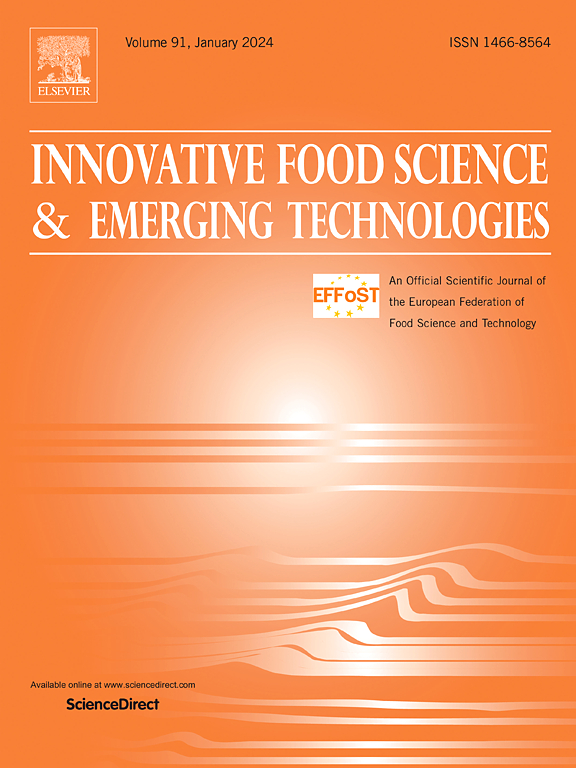Impact of thermal treatment, pulsed electric fields, and high-pressure processing on the transcriptome of Escherichia coli ATCC 8739
IF 6.3
1区 农林科学
Q1 FOOD SCIENCE & TECHNOLOGY
Innovative Food Science & Emerging Technologies
Pub Date : 2025-06-07
DOI:10.1016/j.ifset.2025.104077
引用次数: 0
Abstract
Red fruits are valued for their vitamin C and polyphenol content, but traditional heat preservation methods used in juice and nectar production can significantly reduce these components. Therefore, alternative non-thermal methods are explored to inactivate foodborne enteropathogenic Escherichia coli while maintaining the nutritional value; however, knowledge about the effects of these technologies on bacterial cells is limited. This study analyzed differentially expressed genes of E. coli ATCC 8739 inoculated in strawberry nectar at 7.6 ± 0.2 log cfu/mL after exposure to three treatments with two sets of parameters each, namely thermal treatment, high-pressure processing (HPP), and moderate-intensity pulsed electric field (MIPEF). The highest inactivation efficiency was achieved with HPP at 400 MPa, 1 min, reducing microbial counts by 5.0 ± 0.3 log cfu/mL, and thermal treatment at 60 °C, 200 s, achieving a reduction of 4.4 ± 0.2 log cfu/mL, while no inactivation was observed with MIPEF at 6 kV/cm. Transcriptomic analysis showed that thermal and HPP treatments caused similar molecular stress responses in E. coli. In both cases, the most overexpressed genes encoded outer membrane proteins, (log2FoldChange 1.11–1.57). Despite no microbial inactivation was revealed after MIPEF treatment, strong transcriptomic responses were observed, particularly in genes related to membrane integrity and metabolic activity, like dehydrogenase YhaE (log2FoldChange 7.09). Numerous overexpressed genes associated with ABC transporters, outer membrane proteins, and lipoproteins were identified, which could increase the strain's virulence. This study provided insights into the stress response mechanisms induced by conventional and novel treatments. Nevertheless, further research is needed to investigate the long-term effects on bacterial populations.
热处理、脉冲电场和高压处理对大肠杆菌ATCC 8739转录组的影响
红色水果因其维生素C和多酚含量而受到重视,但在果汁和花蜜生产中使用的传统保温方法会显著减少这些成分。因此,在保持营养价值的同时,探索其他非热方法来灭活食源性肠致病性大肠杆菌;然而,关于这些技术对细菌细胞的影响的知识是有限的。本研究以7.6±0.2 log cfu/mL草莓花蜜为培养基,对大肠杆菌ATCC 8739在热处理、高压处理(HPP)和中等强度脉冲电场(MIPEF)三种处理条件下的基因差异表达进行了分析。HPP在400 MPa, 1 min下达到最高的失活效率,减少微生物计数5.0±0.3 log cfu/mL, 60℃,200 s热处理,减少4.4±0.2 log cfu/mL,而在6 kV/cm的MIPEF下没有观察到失活。转录组学分析表明,高温和高温处理在大肠杆菌中引起相似的分子应激反应。在这两种情况下,过度表达最多的基因编码外膜蛋白,(log2FoldChange 1.11-1.57)。尽管MIPEF处理后没有发现微生物失活,但观察到强烈的转录组反应,特别是与膜完整性和代谢活性相关的基因,如脱氢酶YhaE (log2FoldChange 7.09)。许多与ABC转运蛋白、外膜蛋白和脂蛋白相关的过表达基因被鉴定出来,这可能会增加菌株的毒力。本研究对传统和新型治疗方法诱导的应激反应机制提供了新的见解。然而,需要进一步的研究来调查对细菌种群的长期影响。
本文章由计算机程序翻译,如有差异,请以英文原文为准。
求助全文
约1分钟内获得全文
求助全文
来源期刊
CiteScore
12.00
自引率
6.10%
发文量
259
审稿时长
25 days
期刊介绍:
Innovative Food Science and Emerging Technologies (IFSET) aims to provide the highest quality original contributions and few, mainly upon invitation, reviews on and highly innovative developments in food science and emerging food process technologies. The significance of the results either for the science community or for industrial R&D groups must be specified. Papers submitted must be of highest scientific quality and only those advancing current scientific knowledge and understanding or with technical relevance will be considered.

 求助内容:
求助内容: 应助结果提醒方式:
应助结果提醒方式:


